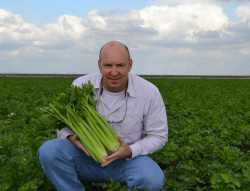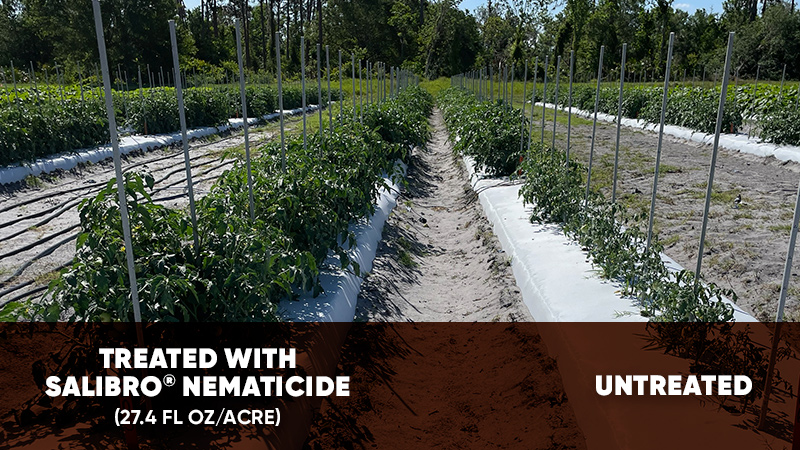Connect With Consumers

Often when one sees big acreage associated with a farming operation, it can be lost on people that, in fact, many of these are still family run businesses. Such is the case with Hundley Farms, which grows roughly 14,000 acres of crops in South Florida, including sweet corn, green beans, celery, radishes, sugar cane, and rice.
“I am a third-generation farmer,” says John S. Hundley, who is vice president of ag operations at Hundley Farms. “My grandfather started the farm here in the Glades in 1935 after moving from Kansas. He started slowly but surely kept building the farm. When my dad graduated from the University of Florida, he took over and has helped build the company to what it is today.
“When I graduated from Florida State University and came back to work on the family farm, I wanted to be surrounded by the very best people I could find who had production experience and a common denominator of dedication to teamwork. I like to say teamwork makes the dream work.”
With a team of around 60 full-time employees, Hundley is managing a successful and well diversified farming operation that places an emphasis on utilizing technology to reach its major objective. “Our goal is to put out the finest quality product that we can produce,” he says. “I don’t take shortcuts, which makes our costs higher, but if I cut those corners, there is a greater potential I will be cutting corners on quality. I put myself in the consumer’s shoes and evaluate our offerings through that lens.”
The use of technology has been integral in improving farming operations and the quality of produce the farm supplies to consumers. Hundley adds that integration of new technologies will only increase in the coming years.
Focused On Precision
Managing the amount of acreage on Hundley Farms requires managing a mountain of data and information. Hundley says detailed databases, as well as the incorporation of precision applications, have streamlined operations and resulted in savings across the board and better marketing decisions.
“Our database is the driving force for all of our future decisions and planning,” says Hundley. “With the different crops we grow, it gives us trends over many years, which are variety specific to certain locations.
“All of our major inputs, such as chemicals and fertilizers, are adjusted and many times reduced from previous years because we can now forecast and prepare for what issues we historically will encounter. The database we use is Geo-referenced to all our farms, and this is a great tool for figuring future land use and crop rotations. With this information, we can put into play ‘what if’ scenarios, so we can forecast land availability for different crops. We use this for all our budgeting a full year or so in advance.”
Auto-steer technology also has had a significant impact on farming operations. The technology is used in planting, cultivation, and chemical applications. The farm utilizes GreenStar technology equipped on its John Deere tractors and sprayers.
“GPS has allowed us to be very precise in our application process whether it is seeds, fertilizers, and chemicals,” says Hundley. “It allows us to achieve a greater success rate with our BMPs, which we’ve utilized on the farm for nearly 15 years. GPS, from a cultivation point of view, helps us get the weeds out mechanically while preserving the crops.”
Other advantages of the GPS technology include less driver fatigue, and when planting, the operator can pay more attention to the planting process and be less focused on the actual navigation of the equipment. It also has resulted in getting more use out of available land and allowed for better calculation of acres in cultivation in fields.
Hundley Farms Connects With Consumers ctd.
On Forefront Of Food Safety
Food safety has always been a top priority at Hundley Farms, but the operation is gearing up for even more regulations as the Food Safety Modernization Act comes online. Hundley says their goal is to have standards that are above what is required.
Hundley Farms participates in Pioneer Growers Cooperative for marketing of its crops. The coop, based in Belle Glade, has an entire department dedicated to food safety, which has been in place for more than a decade. The staff goes through substantial training to keep current on changing food safety requirements and how emerging technologies can improve best practices even more.
Currently, the farm is in negotiations with suppliers of traceability products to prepare for the industry-wide Produce Traceability Initiative. Hundley says they’ve had some obstacles to overcome in terms of finding a technology to tag the wooden crates that some of the operation’s sweet corn is shipped in.
“This process is still being streamlined as the laws are still being written, but mobile devices like smartphones and iPads will be staples in the field for us to give to our sales force, along with receiving and shipping notice of deliveries,” he says. “Electronic data can be sent instantaneously to our packinghouse so that all traceability information can be compiled and added to the containers.”
Hundley credits groups like FFVA and Western Growers for working with Congress and regulators in developing new food safety standards that are not pie in the sky and workable for all sides involved, from growers to the retail chain.
“We are preparing ourselves for tougher regulations, but that is OK,” says Hundley. “Again, I put myself in the consumer’s role and appreciate their demand for safe food. I believe this already is an area where the U.S. distinguishes itself from other countries that are held to a much lower standard when it comes to food safety.”
Value Added
Take a quick tour through any produce section of a grocery store these days and you can see presentation and ease of preparation are clear trends in marketing. For growers, providing this “value-added” appeal to the consumer is essential to stay competitive in today’s marketplace.
Hundley Farms shipped its first value-added sweet corn in 1988, so it has been an innovator in this area of production, packing, and marketing. In addition to sweet corn, the farm bags all of its radish production and bags a lot of its fresh green bean production.
In sweet corn, Hundley provides options of fully de-husked and trimmed ears or windowed out and not fully shucked ears sold in trays.
“Being a consumer myself, I look for the best of what I buy simply because food is not cheap anymore and probably never will be again,” says Hundley. “Knowing that, from my perspective, our farm does everything humanly possible to provide the highest quality product we can.
“In addition, we are investing large amounts of capital to build a new state-of-the-art sweet corn packing line. We are not doing this to lower our costs. We are doing this to help us better control the things we can control, which should equate to a higher quality product for the consumer. Talking about quality is one thing, but providing it takes a will to succeed and a passion to excel well into the future.”
Hundley Farms Connects With Consumers ctd.
Eye Toward Mechanization
Given concerns over labor availability, Hundley Farms is turning toward mechanical harvest as a means to address potential worker shortages in the future. “The problem we have is we grow a perishable product that can’t wait on hand labor for harvest if it is not available,” says John Hundley. “We are investing more and more into mechanization on our sweet corn production to rely less on hand labor. With mechanical corn harvest, we do get a little more damage and shrink in the crop, but not a lot. This is because the harvest technology is advancing so much. Currently, we have invested in two harvesters and are adding a third Pixall harvester this year.”
Consumer Appeal
Hundley says the future of fresh produce production and marketing will be engaging the consumer on a much more intimate level. Here again technology will lead the way. Already growers are utilizing social media to connect with consumers, and new traceability technology will provide benefits beyond just food safety.
“I envision fresh produce being no different than other products a consumer would see in a retail store,” says Hundley. “They will have the ability to easily provide feedback or complain about issues with the product. Interactive websites linking many growers together and different crops also will likely emerge.
“We want to take a step or two closer from the field to the dinner table. The bottom line is technology is driving our business, and while we will never be the biggest, we will try everything to be one of the best. As the head of all of our production, the team I have assembled around me is very goal oriented. We have a driving desire to do what is right where in the end everybody wins.”










